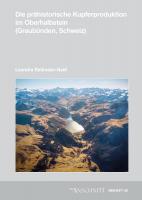Die prähistorische Kupferproduktion im Oberhalbstein (Graubünden, Schweiz)
Schlagworte:
Montanarchäologie, Kupfermetallurgie, Spätbronzezeit, Ältere Eisenzeit, ZentralalpenraumÜber dieses Buch
Das inneralpine Tal Oberhalbstein ist seit langem als bronzezeitliche Siedlungskammer und urgeschichtliche Montanlandschaft bekannt. Systematische montanarchäologische Untersuchungen haben nun mehrere urgeschichtliche Gruben sowie knapp 90 Schmelzplätze ans Licht gebracht. Umfangreiche Serien absoluter Datierungen zeigen, dass die Kupferproduktion in zwei Hauptphasen zu unterteilen ist: eine spätbronzezeitliche (11. Jh. v.Chr.) und eine ältereisenzeitliche (7. Jh. v.Chr.). Die vorliegende Arbeit widmet sich neben der summarischen Vorlage der montanarchäologischen Befunde insbesondere der detaillierten Entschlüsselung der Prozesstechnologie. Anhand von typologischen, morphologischen und archäometrischen Untersuchungen an Verhüttungsschlacken sowie Erzanalysen wird die Prozesskette vom Erzabbau über die bislang nur in Spuren bekannte Aufbereitung bis hin zur Verhüttung nachgezeichnet. Die Publikation verfügt über einen umfangreichen Forschungsdaten-Anhang.
Die Open Access-Version dieser Publikation wird publiziert mit Unterstützung des Schweizerischen Nationalfonds zur Förderung der wissenschaftlichen Forschung.
Fördernr. : 10BP12_206259





